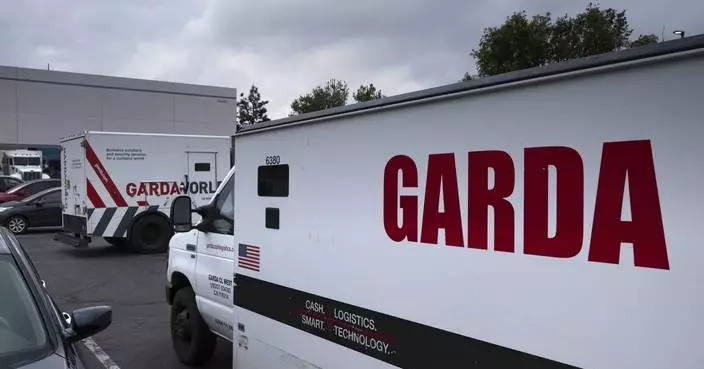Criminal syndicates in South Africa have increased attacks on security vans transporting large amounts of cash, brazenly opening fire and blowing up vehicles in chaotic scenes that send civilians rushing for cover.
Some bystanders manage to film the urban, often daylight attacks and post the footage on social media, magnifying concerns in a country that struggles with a high rate of violent crime.

In this photo taken Thursday, Oct. 23, 2014, a forensics team searches for clues at the scene of a cash in transit heist near the OR Tambo Airport in Johannesburg. Criminal syndicates in South Africa have increased attacks on security vans transporting large amounts of cash, brazenly opening fire and blowing up vehicles in chaotic scenes that send civilians rushing for cover. (AP Photo)
Authorities are boosting intelligence work and other efforts to tackle the heavily armed gangs, whose members appear to have specific roles: shooter, lookout, driver.
"It's almost like everyone's got a skill of his own," said Yusuf Abramjee, a South African anti-crime activist. "These people strike with military precision."
They might be getting help from rogue police officers, and local media have reported the possible use of stolen military weapons in some heists.
There have been 75 attacks on vehicles carrying cash this year, compared to 31 in the same period in 2017, said Kalyani Pillay, CEO of the South African Banking Risk Information Centre, or SABRIC. Just under 40 percent of the attacks were thwarted. Two civilians, one police officer, five guards and nine suspects were killed in this year's robberies and another 93 people were injured, Pillay said.
Thieves carrying out such heists have stolen 63 percent more money this year than in the same period in 2017, according to Pillay. She declined to say how much, though the amount is estimated to be at least several million dollars.
Unions representing workers involved in the transport of cash held protests in major cities in June for more protection on the job. "Stop bombing our cash vans," read a sign at a march in Cape Town.
A parliamentary committee held a hearing on the attacks.
Meanwhile, the rate of attacks on security guards transporting cash on foot between, for example, a business and a vehicle has dropped.
That suggests criminal syndicates are going after more vehicles on the road because they are likely to yield more loot — and that the thieves think they can get away with it, partly due to heavy firepower. Security experts say police, whose response was sometimes lackluster in the past, are more pro-active.
Heist methods have varied over the years. In 1997, thieves in Bronkhorstspruit dragged a spike chain across a highway to block a security van and killed two guards. The hit was reminiscent of a scene in the 1995 movie "Heat" in which a gang uses a spike strip to thwart police pursuit after robbing an armored car.
Today, heist teams in South Africa can consist of 10 to 15 people who blow open armor-plated security vehicles with commercial explosives possibly siphoned off from the mining industry. The teams seem comfortable making their move in crowded areas.
Video of an attack on security vans in May in Boksburg, near Johannesburg, shows a man with a long rifle, apparently a lookout, kneeling at an intersection. An explosion is heard and gunfire crackles. A couple of motorists do hurried U-turns to escape the scene.
A separate video of the same attack, filmed from what appears to be a car showroom at the same intersection, shows smoke rising after an explosion. Three blasts are heard.
"Oh my God! Look how many of them are coming out," a woman says as suspects emerge from a car.
A third video of the aftermath shows a badly damaged security van and banknotes strewn over the road.
In raids last week, police arrested a female police officer who allegedly stored weapons used in the Boksburg heist, as well as her 32-year-old boyfriend. Nearly two dozen people were arrested in the sweep.
Gangs involved in such heists include some people from neighboring countries including Botswana, Mozambique and Zimbabwe.
Police Minister Bheki Cele has said more must be done to stop related "feeder crimes" including carjacking, illegal gun sales and police corruption. Cash heists were down sharply in June compared to May in a sign of improved policing, he said.
Security companies, meanwhile, can do more with technology including dye that stains money if there is a robbery or a foam that automatically covers cash in a vehicle's vault and makes it impossible to remove, said Abramjee, the anti-crime activist.
About 200 people are believed to be "spearheading" the attacks in South Africa, one security company said in response to questions from The Associated Press. There have been 27 attacks on Fidelity Security Group vans this year and just under half were "successfully defended," it said. Four employees were killed and 55 were injured.
The company said it has spent millions of dollars to upgrade vehicles, increase training and take other measures against the threat.
"Unfortunately, as we introduce more measures on land and in the air, the modus operandi of criminals also evolves," Fidelity said.
A brazen Los Angeles cash heist on Easter weekend in which thieves cracked a safe and got away with as much as $30 million is believed to be one of the largest such heists in U.S. history.
The heist has triggered rampant speculation among a public long infatuated with daring burglaries and hefty criminal paydays.
Here are some things to know about the recent theft in Los Angeles and the history of such crimes.
L.A. police and the FBI were tight-lipped Friday about any new developments in their joint investigation, but police Cmdr. Elaine Morales told The Los Angeles Times, which broke news of the crime, that thieves were able to breach the money storage facility in the suburban Sylmar neighborhood and then crack into the safe containing the cash.
Media reports identified the facility as a location of GardaWorld, a global cash management and security company. The Canada-based company, which also operates fleets of armored cars, did not immediately respond Friday to a request for comment from The Associated Press.
Police said officers received a call for service at the facility at 4:30 a.m. Easter Sunday, and aerial footage from KABC-TV showed a large hole on the side of the building that appeared to be boarded up with plywood.
Jim McGuffey, an armored car and physical security expert, called the theft “a shock.” Any such facility should have two alarm systems and a seismic motion detector right on the safe, he said, as well as additional motion sensors throughout the building.
“For that kind of money, you don’t just walk in and walk out with it,” he told AP. “A facility should be protected from the top to the bottom and the sides.”
Randy Sutton, a former police detective in New Jersey and Las Vegas who investigated major crimes and high-end burglaries, said a crime of this magnitude had likely been planned for months or longer and involved numerous people.
“This took a tremendous amount of research and tremendous amount of knowledge on the technical end regarding the circumvention of security systems and surveillance,” he said.
He said much of the cash at a facility like the one operated by GardaWorld has already been in circulation, so unless it comes directly from the U.S. Treasury, the majority of it may not be traceable.
He added that law enforcement has almost certainly started interviewing anyone who worked at GardaWorld or knew anything about its security protocols.
“You can bet that not just current employees of that organization are going to be scrutinized, but prior employees as well,” he said.
Law enforcement officials have not discussed details of the cash that was stolen, but regardless of the denomination of the bills, such a massive amount of cash would be difficult to move and transport.
The weight of $1 million in $100 bills alone is about 22 pounds (10 kilograms), according to testimony from a U.S. Treasury official to Congress. If the cash were in various denominations, like $5s, $10s and $20s, the weight of $1 million in cash could be closer to 250 pounds (115 kilograms), which could bring the overall weight of last weekend's haul to a whopping 7,500 pounds (3,400 kilograms), or about 3 1/2 tons (3.18 metric tonnes).
Sutton said it's likely the criminals who pulled of the caper already had a plan in place for how to launder that much money.
“It's an interesting question: How do you get rid of that amount of cash?” he said. “I know it's a quandary we'd all like to have, but the reality is these criminals probably had that in their repertoire.”
Although the largest cash heist in the world is believed to be the plundering of the Central Bank of Iraq during the U.S. invasion in 2003, and other large cash heists have been pulled off in Europe and South America, the Los Angeles heist would be among the largest ever in the U.S.
The 1997 armed robbery of nearly $19 million at the Los Angeles Dunbar Armored Co. depot was the largest cash robbery in U.S. history at the time, according to the Los Angeles Times. That caper, during which five armed robbers in black clothing and masks tied up a handful of workers at the depot, was planned with the help of a former employee at the facility. It took years to crack the case, and although all five culprits were caught, most of the cash was never recovered.
Although not a cash heist, nearly two years ago, as much as $100 million in jewels and other valuables were stolen from a Brink’s big rig at a Southern California truck stop. The thieves haven’t been caught.
People have long been obsessed with big-money heists, as evidenced by the key role these criminal jobs play in movies, films and television. A central theme of the 1990 mobster classic “Goodfellas” is the true story of the Lufthansa heist in 1978, when gangsters made off with just under $6 million in cash and jewelry in what was the largest U.S. heist at the time.
The blockbuster 2001 heist film “Ocean's 11,” which was a remake of a 1960 movie of the same name, also featured an ensemble cast determined to steal $160 million from a Las Vegas casino. That film spawned several sequels that centered on elaborate heists.
A popular heist film set in Los Angeles, 1995's “Heat,” features a group of elite professional thieves who target armored cars and bank vaults. The film stars Robert DeNiro as an L.A.-based thief and his crew looking to make a final $12 million bank heist while being chased by an L.A. detective played by Al Pacino.
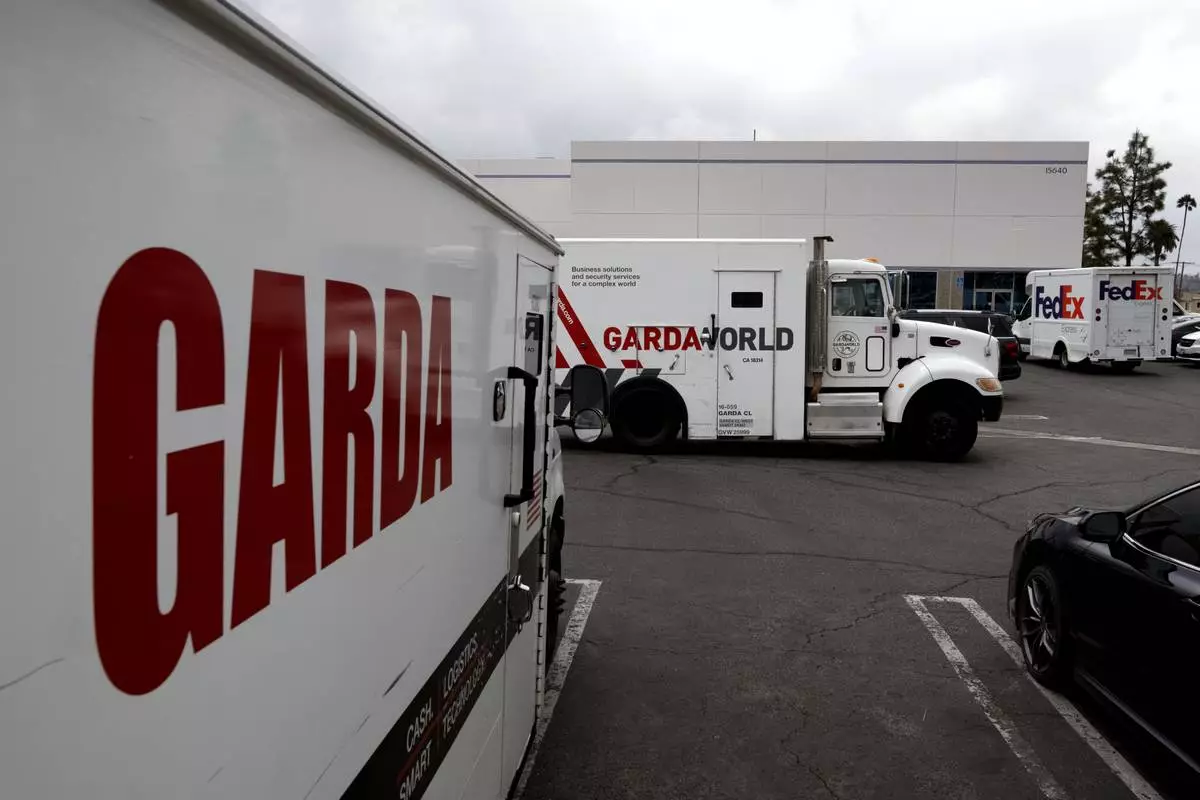
Armored trucks are parked outside the offices of GardaWorld in the Sylmar section of Los Angeles on Thursday, April 4, 2024. Thieves stole as much $30 million in an Easter Sunday burglary at a Los Angeles money storage facility in one of the largest cash heists in city history. (AP Photo/Richard Vogel)
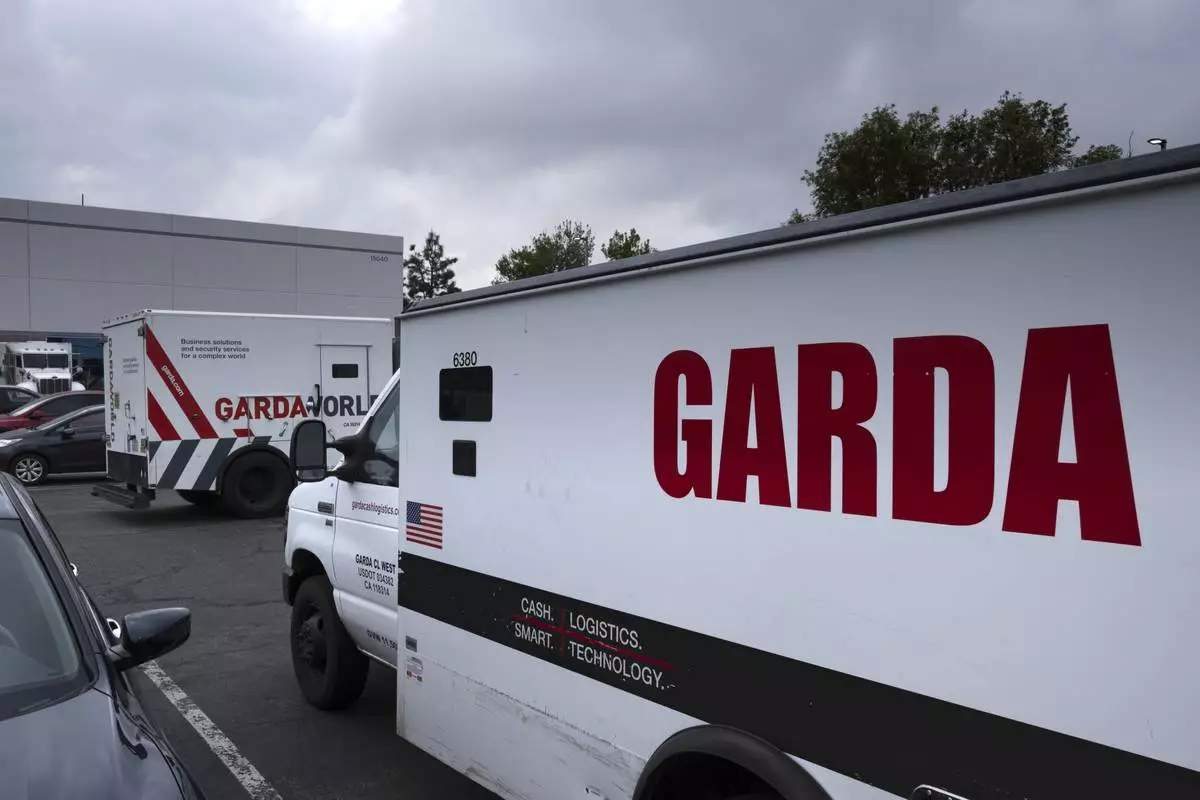
Armored trucks are parked outside the offices of GardaWorld in the Sylmar section of Los Angeles on Thursday, April 4, 2024. Thieves stole as much $30 million in an Easter Sunday burglary at a Los Angeles money storage facility in one of the largest cash heists in city history. (AP Photo/Richard Vogel)
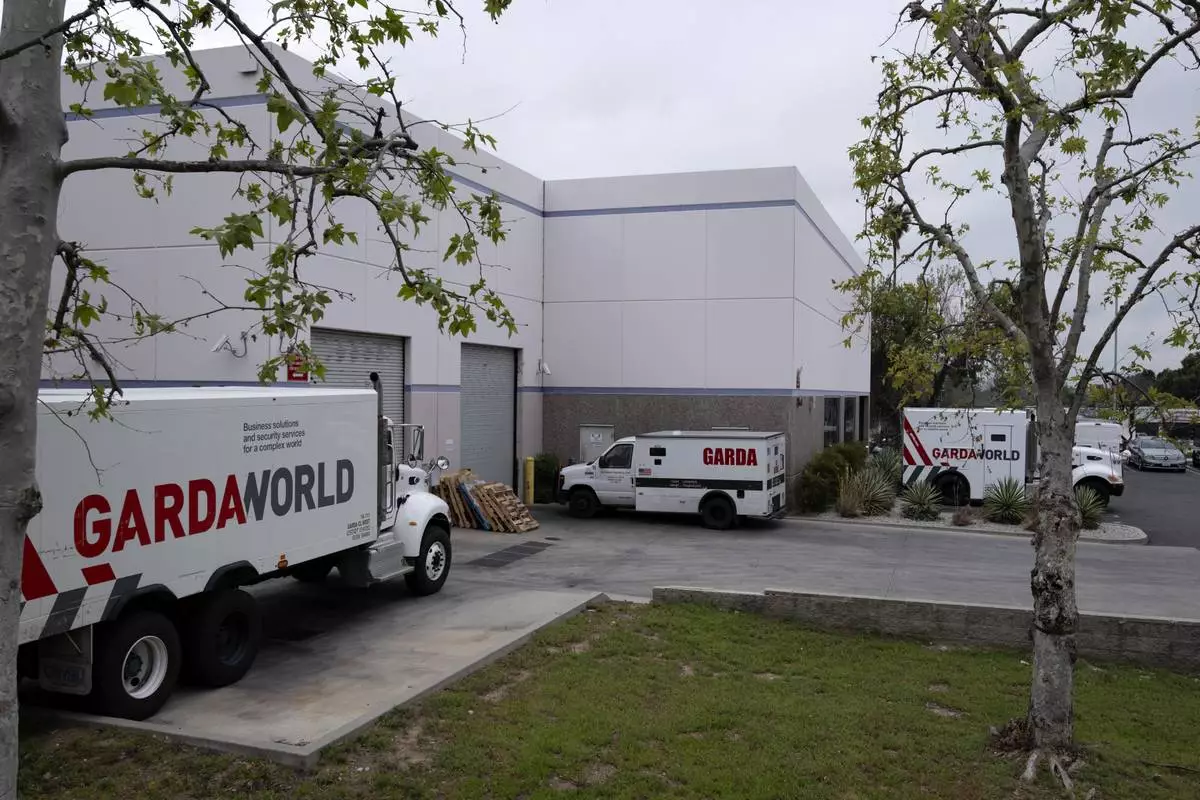
Armored trucks are parked outside the GardaWorld facility in the Sylmar section of Los Angeles on Thursday, April 4, 2024. Thieves stole as much $30 million in an Easter Sunday burglary at a Los Angeles money storage facility in one of the largest cash heists in city history. AP Photo/Richard Vogel)
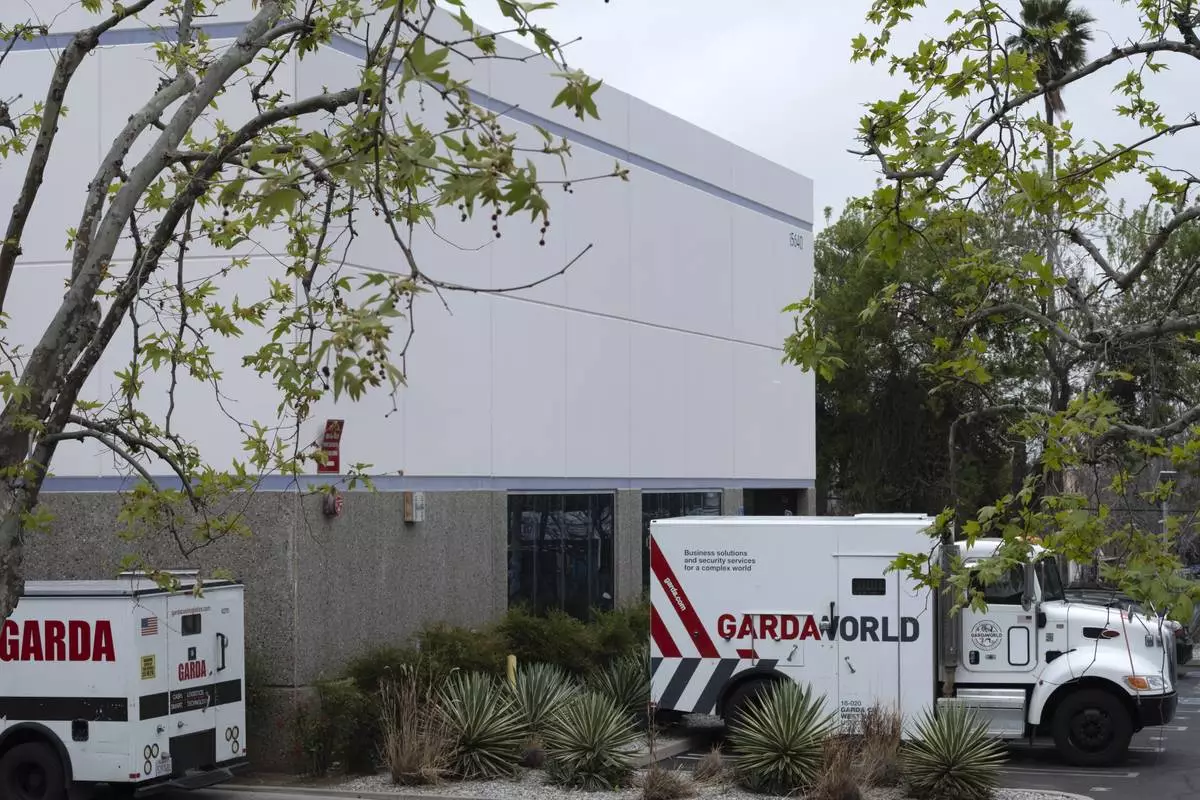
Armored trucks are parked outside the GardaWorld facility in the Sylmar section of Los Angeles on Thursday, April 4, 2024. Thieves stole as much $30 million in an Easter Sunday burglary at a Los Angeles money storage facility in one of the largest cash heists in city history. (AP Photo/Richard Vogel)








